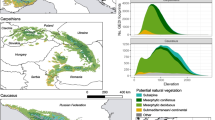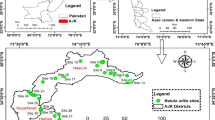Abstract
Mao'ershan region is representative in the natural secondary forested region of the eastern mountainous region, northeast China. The landscape nearest neighbor index and landscape connectivity index were calculated with ARC/INFO software for Mao'ershan region. The spatial distribution of the landscape of the region was analyzed. The results showed that the landscape connectivity index of non-woodland was significantly higher than that of woodland. The landscape connectivity index of natural forest was nearly equal to zero, which means its fragmentation degree is high. The nearest neighbor index of plantation was lower than that of natural forest and non-forestland. Among the man-made forests, the distance index of the coniferous mixed plantation is the lowest, and its pattern is nearly glomeration. The landscape pattern of natural forest presented nearly random distribution. Among non-forest land, the distance index of cut blank was the lowest, and its pattern was also nearly glomeration.
Similar content being viewed by others
References
Chang Xueli and Wu jianguo 1998 Spatial analysis of pattern of sandy landscapes in Kerqin, Inner Mongolia [J]. Acta Ecologica Sinica,18(3): 225–232.
Chen Dake, Zhou Xiaofeng, Zhuning,et al. 1994. Natural secondary forest-structure, function, dynamic and management [M]. Haerbin: Northeast Forestry University Press, 1–30.
Clark, P.J. and Evans, F.C. 1954 Distance to nearest neighbor as a measure of spatial relationships in population [J]. Ecology,35(4): 445–453
Forman, R.T.T. and Baudry, J. 1984. Hedgerows and hedgerow network in landscape ecology [J]. Environmental Management,8: 495–510.
Forman, R.T.T. and Godron, M. 1986. Landscape Ecology [M]: New York: John Wiley & Sons, p 619–620.
Guo Jinping, 2001. Forest landscape ecology research [M]. Beijing: Beijing University Press, p 196–200 (in Chinese).
Li Habin and Wu Yegang. 1992. Mathematic Research Methods of Landscape Ecology [M]. Beijing: China Science and Technology Press, p209–234 (in Chinese).
Ma Keming and Fu Bojie 2000. Spatial neighboring and distribution regularities of landscape types in Donglingshan mountain region, Beijing, China [J]. Acta Ecologica Sinica,20(5): 748–752.
Mcdonnell, M.J. and Pickett, S.T.A. 1988. Connectivity and the theory of landscape ecology [C]. In: Schreiber, K.F. (eds), Connectivity in Landscape Ecology, Proceeding of the 2nd international Seminar of the “International Association for landscape ecology”, Munstersche Geographische Arbeiten 29, Munster, 17–19.
Merriam, G. 1988 Landscape dynamics in farmland [J]. TREE,3: 16–20.
Merriam, G. 1991. Corridors and connectivity: animal population in heterogeneous environments [C]. In: Saunders D A and Hobbs R J (eds). Nature Conservation 2: The Role of Corridors. Chipping Norton: Surrey Beatty & Sons, p 133–142.
Taylor, D.P., Merriam, G. 1996 Habitat fragmentation reduces parasitism of a forest damselfly [J]. Landscape Ecology,11(3): 181–189.
Wu, J. and Vankat, J.L. 1993. Effects of patch connectivity and arrangement on animal metapopulation dynamics: a simulation study [J]. Ecological Modelling,65: 221–254.
Wu Jianguo 2000. Landscape Ecology—Pattern, Process, Scale and Hierarchy [M]. Beijing: Higher Education Press, p100–109 (in Chinese).
Yue Depeng, Wang Dongmei, Zhao Tingning,et al. 1997. Study on landscape pattern and ecology change in Beizang town Daxing country, Beijing [J]. Journal of Beijing Forestry University,19(2): 35–41.
Author information
Authors and Affiliations
Corresponding author
Additional information
Foundation item: This paper was supported by the Key Project of State Department of Science Technology (2002BA515B040).
Biography: LI SHu-juan (1977), female. Lecture in Ocean University of China, Qingdao 266003, P. R. China.
Responsible editor: Zhu Hong
Rights and permissions
About this article
Cite this article
Shu-juan, L., Yu-zheng, S., Hai-qing, F. et al. Spatial connectivity and distribution of landscape type in the natural secondary forests of eastern mountainous region, northeast China—a case study of Mao'ershan region in Heilongjiang Province. Journal of Forestry Research 15, 141–144 (2004). https://doi.org/10.1007/BF02856750
Received:
Issue Date:
DOI: https://doi.org/10.1007/BF02856750
Keywords
- Landscape type
- Landscape pattern
- Nearest neighbor index
- Landscape connectivity index
- Natural secondary forest
- Northeast China




